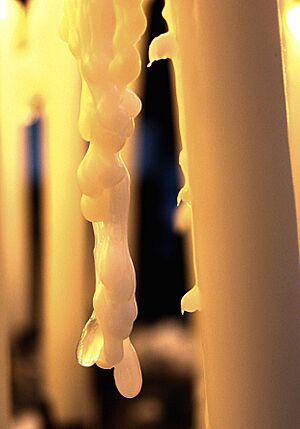Amorphous solid facts for kids
An amorphous solid is a special type of solid that does not have a neat, repeating shape like a crystal. Imagine building with LEGOs: a perfect LEGO house has a clear, repeating pattern, but an amorphous solid is more like a messy pile of LEGOs. In these solids, the tiny particles (called atoms or molecules) are not arranged in a long, organized pattern.
Many things you see every day are amorphous solids. For example, the glass in your windows is an amorphous solid. Many polymers, which are used to make plastics, are also amorphous. Even some foods, like cotton candy, are amorphous solids!
Contents
What is an Amorphous Solid?
An amorphous solid is any solid that is not crystalline. This means its atoms and molecules are not arranged in a definite, repeating pattern. They are more randomly placed.
- Amorphous solids do not have a specific geometric shape.
- Their particles are not organized in a neat, repeating structure.
- They are different from crystalline solids, which have a very ordered structure.
Amorphous vs. Crystalline Solids
Think of the difference between a diamond and a piece of glass. Both are solids, but they are very different.
- Crystalline solids like diamonds have their atoms arranged in a very organized, repeating pattern. This pattern is called a crystal lattice.
- Amorphous solids like glass do not have this neat, repeating pattern. Their atoms are arranged more randomly.
This difference in arrangement gives them different properties. For example, crystals often break along flat surfaces, while amorphous solids tend to shatter into irregular pieces.
How Amorphous Solids are Different from Liquids
Solids and liquids are both forms of matter where particles are close together. But they behave very differently.
- Solids have a definite shape and a definite volume. They resist changes to their shape. If you bend a solid, it usually springs back to its original shape.
- Liquids have a definite volume, but their shape changes to fit their container. Liquids can flow easily.
Amorphous solids are true solids because they hold their shape and do not flow like liquids. They are just solids without the perfect internal order of crystals.
Examples of Amorphous Solids
You can find amorphous solids all around you:
- Glass: This is a very common amorphous solid. Window panes, bottles, and drinking glasses are all made of amorphous glass.
- Plastics: Many types of plastics, like those used in toys, containers, and phone cases, are amorphous.
- Rubber: The rubber in tires and elastic bands is also an amorphous solid.
- Wax: Candles are made of wax, which is an amorphous solid.
- Cotton Candy: This sweet treat is a great example of an amorphous solid in food.
Related pages
Images for kids
See also
 In Spanish: Sólido amorfo para niños
In Spanish: Sólido amorfo para niños



